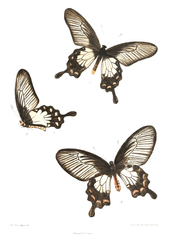Pachliopta pandiyana
| Malabar rose | |
|---|---|
 | |
| Scientific classification | |
| Kingdom: | Animalia |
| Phylum: | Arthropoda |
| Class: | Insecta |
| Order: | Lepidoptera |
| Family: | Papilionidae |
| Genus: | Pachliopta |
| Species: | P. pandiyana |
| Binomial name | |
| Pachliopta pandiyana[1] (Moore, 1881) | |
| Synonyms | |
|
Atrophaneura pandiyana | |
Pachliopta pandiyana, the Malabar rose, is a swallowtail butterfly belonging to the Pachliopta genus, the roses or red-bodied swallowtails. It resembles the common rose (Pachliopta aristolochiae) from which it can be differentiated by the much larger white patch on its hindwings.
It is an important endemic butterfly of South India.
Description
This was earlier considered a race of Pachliopta jophon found in Sri Lanka.

Race pandiyanus, Moore. "Though closely allied to A. jophon gray, this species is constantly different in pattern. The white colour of the forewings is much more extended, especially in the apical region, but also more shaded with black scales; the internervular black streaks between the median nervures (veins 4-6) are much longer, the white linear markings, in the cell reach the discocellular veinlets. On the hindwing the last discal white spot reaches mostly to the submedian nervure (vein 1), the anterior one is very large in the male, small or divided into two spots, or obliterated in the female...". (Rothschild, quoted in Bingham)
Similar species

Range
Southern India. The butterfly does not associate much with the common rose, which it resembles. On the western slopes of the Nilgiris and elsewhere on the Western Ghats, the Malabar rose entirely displaces that most abundant butterfly.
Status
It is uncommon, but not considered to be threatened as a species. The species is locally common in the Western Ghats.
Taxonomy
- A related species, Pachliopta jophon, once considered conspecific, flies in Sri Lanka.
- No separate subspecies have been described.
Habitat
This butterfly is confined to the wet jungles of southern India and the Western Ghats, between 1,000 and 3,000 feet (300 and 910 m).
Habits
The flight of this butterfly resembles that of the common rose (Pachliopta aristolochiae). Early in the morning till about 10 am, it keeps low and feeds from flowers, usually those of the Lantana. Later in the day it flies high and is difficult to capture.
Life cycle
Appears to be single-brooded and is most common common in September and October.
Food plants
The larval food plant is Thottea siliquosa (Aristolochiaceae).
See also
Cited references
- ↑ Häuser, Christoph L.; de Jong, Rienk; Lamas, Gerardo; Robbins, Robert K.; Smith, Campbell; Vane-Wright, Richard I. (28 July 2005). "Papilionidae – revised GloBIS/GART species checklist (2nd draft)". Entomological Data Information System. Staatliches Museum für Naturkunde Stuttgart, Germany. Retrieved 21 June 2013.
References
- Collins, N. Mark; Morris, Michael G. (1985). Threatened Swallowtail Butterflies of the World: The IUCN Red Data Book. Gland & Cambridge: IUCN. ISBN 978-2-88032-603-6.
- Evans, W.H. (1932). The Identification of Indian Butterflies (2nd ed.). Mumbai, India: Bombay Natural History Society.
- Gaonkar, Harish (1996). Butterflies of the Western Ghats, India (including Sri Lanka) - A Biodiversity Assessment of a Threatened Mountain System. Bangalore, India: Centre for Ecological Sciences.
- Gay, Thomas; Kehimkar, Isaac David; Punetha, Jagdish Chandra (1992). Common Butterflies of India. Nature Guides. Bombay, India: World Wide Fund for Nature-India by Oxford University Press. ISBN 978-0195631647.
- Kunte, Krushnamegh (2000). Butterflies of Peninsular India. India, A Lifescape. Hyderabad, India: Universities Press. ISBN 978-8173713545.
- Wynter-Blyth, Mark Alexander (1957). Butterflies of the Indian Region. Bombay, India: Bombay Natural History Society. ISBN 978-8170192329.
External links
- http://www.angelfire.com/journal2/chinfahshin/history/rose.html
- http://www.srilankaninsects.net/Butterflies/Papilionidae/CommonRose/CommonRose.htm